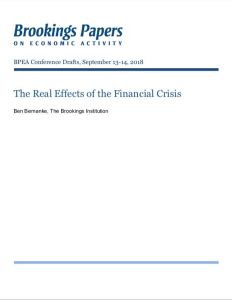Rejoignez getAbstract pour lire le résumé !

Rejoignez getAbstract pour lire le résumé !
Ben Bernanke
The Real Effects of the Financial Crisis
Brookings Institution, 2018
Aperçu
Macroeconomic models should use credit factors in forecasting.
Recommendation
The 2008 financial crisis and the Great Recession that followed laid bare the inadequacy of macroeconomic models to forecast economic dislocations and their cascading effects on households, businesses and financial institutions. Since then, a growing body of research has studied more fully the interrelationship between financial crises and the state of the general economy. In this rigorous study for academics and financial professionals, former Federal Reserve chair Ben Bernanke explains why quantitative models should incorporate several important credit market metrics.
Summary
About the Author
Ben Bernanke is a distinguished fellow at the Brookings Institution and a senior adviser to investment firms Citadel and PIMCO.




















Comment on this summary